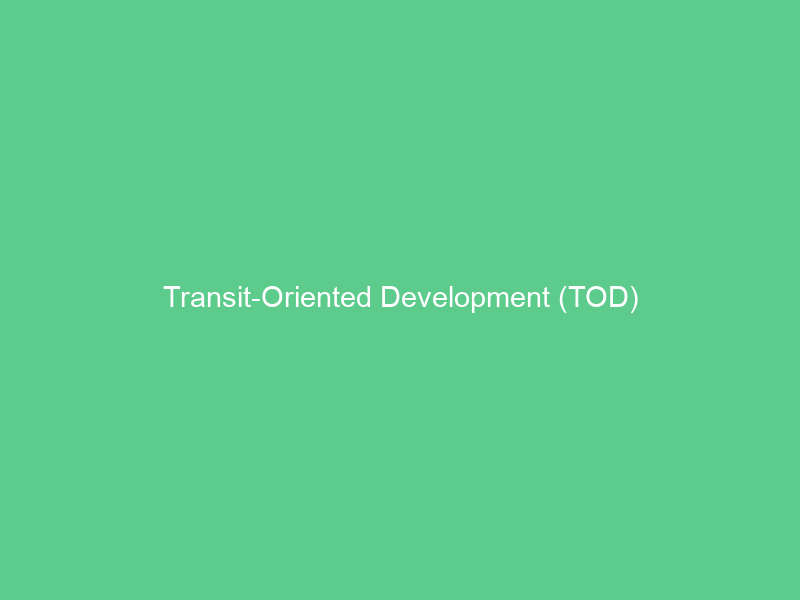TOD usually involves areas surrounding transit stations or corridors, and it has proven most successful in dense, mixed-use neighborhoods within walking distance from high capacity transit services.
TOD can be applied to large cities with extensive networks as well as smaller communities with single stations. All of these communities share the goal of creating vibrant centers of activity in sustainable neighborhoods that create vibrant centers of activity and neighborhoods connected by transportation networks.
High-density residential and commercial buildings
TOD (Transit-Oriented Development) refers to the creation of walkable communities around transit stations that feature housing, offices and shops – giving residents a variety of services, potentially increasing local economies while expanding opportunities for low-income residents and decreasing dependence on fossil fuels.
TOD zones permit higher residential building heights, wider lot coverage, and reduced parking requirements than traditional residential zoning requirements, enabling an array of home types and floor plans while also helping communities repurpose land that would otherwise be dedicated to single-family homes or suburban office parks.
Keep in mind that TOD is a planning strategy, not an inflexible set of rules. In order to be effective, TOD requires working collaboratively with communities to establish goals and policies consistent with local needs and regulations as well as implement an appropriate zoning ordinance and comprehensive plan – this ensures TOD contributes towards long-term success for both community and transit systems while being equitable in its implementation.
Walkable neighborhoods
Communities thrive when residents can easily access shopping, dining, and other amenities within walking distance of home. Transit-oriented development – which centers housing and activities around public transit – promotes local commerce while raising property values and improving quality of life for its residents.
TOD projects typically are within walking distance from bus stops, light rail stations or train depots and feature higher density neighborhoods with both residential and commercial space. These developments are built for pedestrians with narrower blocks and reduced surface area dedicated to automobile parking.
TOD can address barriers to economic opportunity and social inclusion by creating walkable neighborhoods accessible for people of all ages, abilities and socio-economic backgrounds. Furthermore, TOD can prevent displacement of existing residents and businesses through strategies such as community land trusts, rent control policies or inclusive zoning that requires affordable housing in new developments. Furthermore, TOD helps minimize urban sprawl impacts while protecting natural landscapes and wildlife habitats – something urban sprawl can only do so much for.
Access to jobs and services
Residents benefit from living near transit stations and corridors with various housing types and sizes within walking distance, providing them with more options to commute, run errands, meet basic needs and go out and about without their cars. Furthermore, proximity to jobs and services enhances economic activity locally while increasing property values.
Transit-oriented development (TOD) and density can often be mistaken as synonyms, however TOD refers to the creation of compact, walkable communities around transit nodes with multi-family residential projects and office, retail and civic uses in addition to multi-family residential.
eTOD also emphasizes diversity of land use and more sustainable modes of transportation, like walking, cycling and public transit, in order to reduce carbon emissions and the need for new roadway infrastructure. In order to be truly equitable, TOD must include affordable housing. This will enable low and moderate income households to benefit from all its many advantages; to do this we must ensure land use laws support eTOD.
Connected communities
Many residents of TOD communities can reap the benefits of multiple transportation options, including walking and bicycling. For households without access to cars, this means easier and more reliable access to jobs, services, social and cultural events and activities – while for the community as a whole it may mean healthier streets that are safer for all users.
TOD can revitalize existing neighborhoods by drawing in new investment and businesses, while simultaneously improving quality of life by decreasing traffic congestion and air pollution. Furthermore, by creating connected communities with low-income housing options available they may help ease some of the financial strain of living within TOD areas.
TOD works best when early planning includes outreach efforts targeting historically disadvantaged communities. Data can provide the proof necessary for these outreach efforts by validating that a project will promote equity for its target community, such as through local hiring initiatives or outlining the number of well-paying jobs that will be created as part of their development process.

